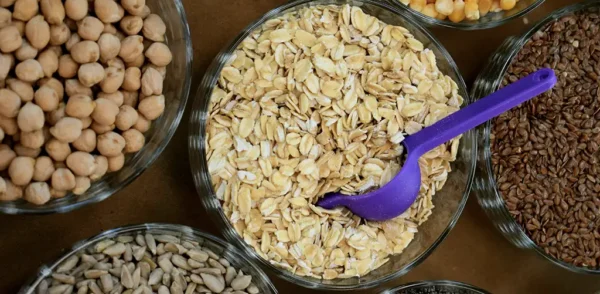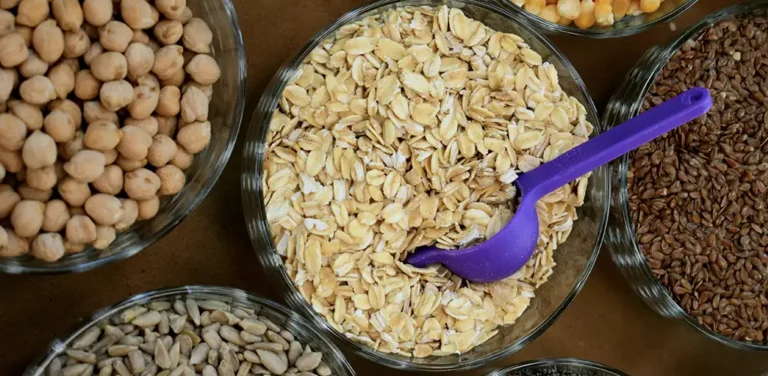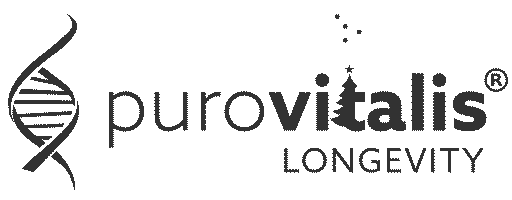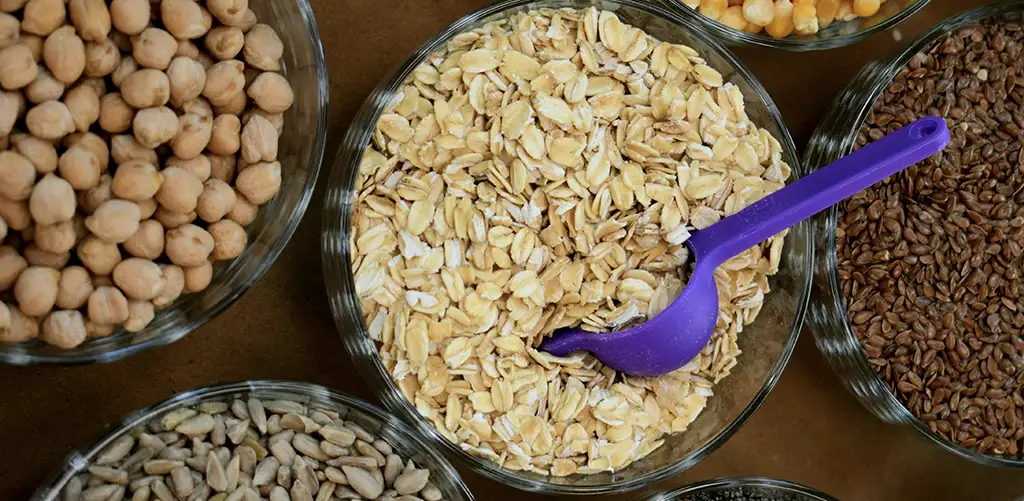
table of contents
- L-cysteine sources
- Animal sources of L-Cysteine
- Plant sources of L-Cysteine
- Glycine + NAC from diet?
- Supplementation the right way
Your body doesn’t get NAC or glutathione from food—but it can make both, if it has enough L-cysteine.
Glutathione is often called the body’s “master antioxidant,” and NAC (N-acetylcysteine) helps your body make it. But neither of them is found directly in your meals. Instead, the process starts with an amino acid: L-cysteine.
L-cysteine is found in many protein-rich foods like eggs, chicken, and legumes. Once absorbed, your body can use it to create NAC—and from there, build up its own stores of glutathione. That’s why your diet plays a key role in antioxidant defense, detoxification, and healthy aging.
In this article, we’ll look at the best food sources of L-cysteine, both animal- and plant-based, and how combining the right nutrients can support your body’s natural production of glutathione.
L-cysteine sources
L-cysteine is a sulfur-containing amino acid found in many protein-rich foods. Your body can make small amounts on its own, but getting it from your diet helps support important processes like glutathione production and detoxification. You’ll find L-cysteine in both animal and plant-based foods, though animal sources tend to be more concentrated. Meat, eggs, and dairy are especially rich, while legumes, nuts, and seeds offer plant-based options. In the sections below, we’ll explore the best animal and plant sources of L-cysteine – and how your diet can help maintain a healthy antioxidant balance.
Animal sources of L-Cysteine
Animal-based foods are among the best sources of L-cysteine. Since this amino acid is naturally present in protein, foods like meat, poultry, fish, eggs, and dairy offer high levels – especially compared to plant-based options.
Poultry such as chicken and turkey is particularly rich in L-cysteine, and pork, beef, and organ meats like liver contain even higher concentrations. Eggs – especially the whites – are another excellent source, offering high-quality, easily absorbed protein. Dairy foods like cheese and yogurt contribute smaller amounts, but can still help.
Here’s a quick overview of some top animal-based sources:
| Food item | Approx. L‑Cystine (mg/100 g) |
|---|---|
| Roasted chicken leg (with skin) | ~740 mg |
| Braised lamb (lean cut) | ~721 mg |
| Grilled pork tenderloin | ~644 mg |
| Roasted goose | ~636 mg |
| Braised pork chop (with fat) | ~616 mg |
| Raw chicken leg (boneless, skinless) | ~599 mg |
| Braised pork chop (lean) | ~595 mg |
| Grilled beef steak | ~587 mg |
| Cooked chicken breast (lean) | ~571 mg |
| Boiled egg | ~480 mg |
Including a mix of these foods in your meals can help maintain healthy L-cysteine levels – supporting antioxidant production, liver function, and overall well-being.
Plant sources of L-Cysteine
While plant-based foods generally contain less L-cysteine than animal products, a well-balanced diet can still provide enough – especially when combining different sources of protein. Legumes, nuts, seeds, and whole grains are the best plant-based options.
Soy products like tofu and tempeh are particularly rich in L-cysteine. Lentils, chickpeas, and beans also contribute solid amounts, along with nuts such as walnuts and pistachios. Whole grains like oats and brown rice provide moderate levels and work well as part of a varied, plant-forward diet.
Here’s a look at common plant-based sources of L-cysteine:
| Food item | Approx. L‑Cystine (mg/100 g) |
|---|---|
| Raw oats | ~636 mg |
| Oat bran (raw) | ~541 mg |
| Boiled soybeans (edamame) | ~461 mg |
| Cooked lentil sprouts | ~328 mg |
| Cooked lupin beans | ~319 mg |
| Cooked split peas | ~249 mg |
| Cooked lentils | ~234 mg |
| Cooked green soybeans | ~203 mg |
| Cooked chickpeas | ~195 mg |
| Cooked white beans | ~190 mg |
Glycine + NAC from diet?
So, you won’t find GlyNAC in food directly – but your diet can still support the same biological pathway. “GlyNAC in food” refers to the idea of combining glycine- and cysteine-rich foods to mimic the benefits of GlyNAC supplementation: boosting glutathione, improving mitochondrial health, and supporting cellular resilience.
Glycine is abundant in collagen-rich cuts of meat, bone broth, gelatin, and pork skin. Plant-based sources include spinach, kale, soy products, and legumes, though in lower concentrations.
For L-cysteine, animal sources like chicken, pork, liver, and eggs rank highest – and as you can see in the table above, they clearly provide the most concentrated sources. Plant-based options like oats, edamame, and lentils also contribute, though typically in smaller amounts.
While your body can produce glutathione naturally from these building blocks, the clinical effects seen with GlyNAC often require higher, targeted doses. Still, combining glycine- and cysteine-rich meals – like eggs with spinach, or lentils with tofu – can promote antioxidant activity and help maintain glutathione levels.
“GlyNAC in food” isn’t a formal nutrient, but the logic behind it is real. Think of it as a strategic pairing: glycine and L-cysteine working together in your meals, just like they do in supplements. Smart food combinations can help your body stay resilient and well-defended – especially when consistently included in your diet.
Supplementation the right way
While food lays the foundation, some benefits of GlyNAC are hard to match through diet alone. That’s where smart supplementation comes in. At Purovitalis, our GlyNAC formulation is designed to support healthy aging at the cellular level. Each vegan capsule delivers 300 mg of L-glycine and 300 mg of NAC (N-acetylcysteine)—two amino acids that help drive the body’s own production of glutathione.
Higher glutathione means less oxidative stress, better mitochondrial function, and faster cellular repair. It’s a formula that not only supports energy and recovery, but also contributes to better sleep—an often overlooked benefit of optimal redox balance.
Read much more about GlyNAC and sleep right here: GlyNAC and sleep improvement
In a clinical study on older adults, GlyNAC supplementation over 24 weeks was shown to restore glutathione levels, reduce oxidative stress, and improve mitochondrial function. Participants also experienced better insulin sensitivity, reduced inflammation, improved muscle strength, faster gait speed, and enhanced cognitive performance. These findings suggest that consistent GlyNAC supplementation may help address several biological markers of aging at once.
How GlyNAC fits into a longevity routine
Purovitalis GlyNAC is made in the EU under strict GMP standards, and every batch is third-party tested. It’s sugar-free, allergen-friendly, and designed for consistent, daily use.
GlyNAC also pairs well with other supplements in a long-term longevity routine. For example, NMN supports NAD⁺ levels and energy metabolism, while spermidine contributes to cellular renewal. Ingredients like resveratrol, vitamin D3, and quercetin further support inflammation control, immune balance, and healthy aging. Combined, they create a complementary system that supports vitality from multiple angles.
Want to read more about GlyNAC and how you can improve your cognitive and mental health? Read more here: GlyNAC for cognitive and mental health
References
- MyFoodData. Nutrient Ranking Tool: Cystine [Internet]. MyFoodData.com; 2024 [cited 2025 Aug 1]. Available from: https://tools.myfooddata.com/nutrient-ranking-tool/Cystine/All/Highest
- USDA FoodData Central. United States Department of Agriculture Agricultural Research Service [Internet]. 2024 [cited 2025 Aug 1]. Available from: https://fdc.nal.usda.gov/
- Sekhar RV. GlyNAC supplementation improves glutathione deficiency, oxidative stress, mitochondrial dysfunction, inflammation, aging hallmarks, metabolic defects, muscle strength, cognitive decline, and body composition: implications for healthy aging. J Nutr. 2021 Dec;151(12):3606–3616.
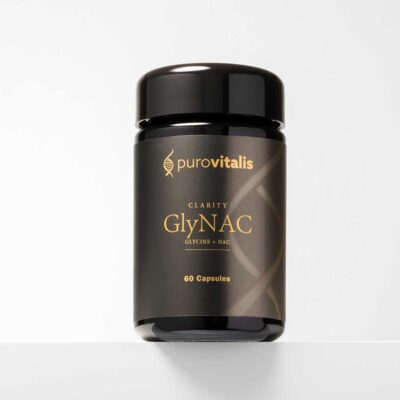
GlyNAC – Powerful Cellular Synergy Support glutathione production Fuel cellular energy
Experience the proven synergy of Glycine and N-Acetyl-Cysteïne. Together, they work more effectively than alone to restore glutathione levels, enhance mitochondrial function, and reduce oxidative stress.

Track 50+ health metrics with AI-powered accuracy. Start your free trial today and take control of your wellness journey!
